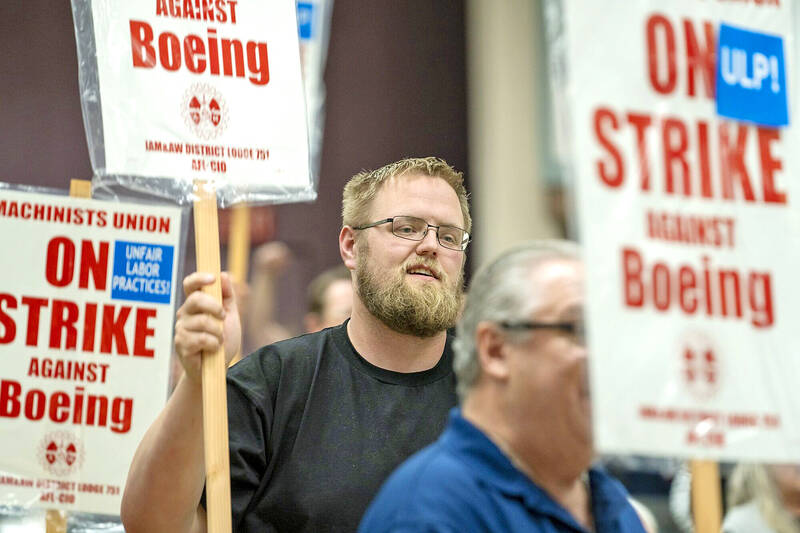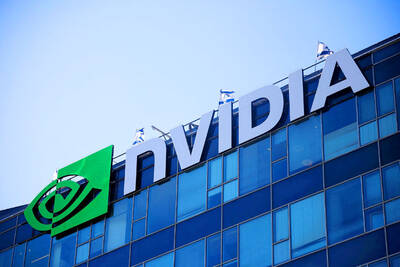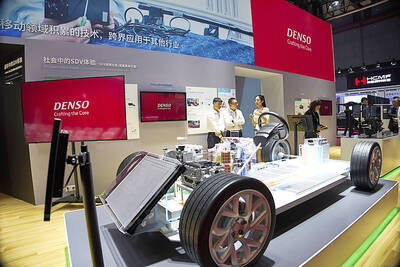Boeing Co factory workers early yesterday walked off the job for the first time in 16 years, crippling manufacturing across its Seattle commercial jet hub after members of its largest union rejected a contract offer and voted to strike.
Members of the International Association of Machinists and Aerospace Workers (IAM), which represents 33,000 Boeing employees across the US west coast, on Thursday voted overwhelmingly to strike in Seattle, with 94.6 percent voting to reject the offer and 96 percent supporting a strike. They downed tools officially at midnight local time.
While both parties have expressed a desire to get back to the bargaining table sooner rather than later, the move adds to the strain on Boeing. The company was already reeling from the fallout over quality lapses after a near-catastrophe at the start of this year that spurred investigations, a customer revolt and an executive shake-up.

Photo: Scott Brauer, Bloomberg
“This has been a long time coming, our members spoke loud and clear tonight,” IAM District 751 president Jon Holden said to a packed hall of union members and media. “Clearly there were aspects of this agreement that weren’t good enough.”
By the time he finished speaking, the chants of “strike, strike” were deafening.
Boeing builds 737 Max jetliners at its Renton factory on the outskirts of Seattle, and makes 777 and 767 models at its Everett facility to the city’s north.
Boeing’s offer did not compensate for 16 years of stagnant wages, higher out-of-pocket healthcare costs and the relocation of thousands of union jobs, Holden said.
“There’s a lot at stake here for our members, so I am proud of them,” he said. “And we’re going to get back to the table as quickly as we can.”
Boeing said in a statement that it remains “committed to resetting our relationship with our employees and the union, and we are ready to get back to the table to reach a new agreement.”
By striking, members ignored a plea for peace by new Boeing CEO Kelly Ortberg, who has vowed to reset labor relations. They also bucked the recommendation of their own union leaders that they accept terms that included a 25 percent guaranteed wage increase over four years. While that was the largest such pay hike ever offered by the planemaker, workers had expected a far greater increase. They were also angered that the terms eliminated an annual bonus.
Boeing has been in a financially difficult situation since a Jan. 5 accident exposed deficiencies at its factories and forced the planemaker to reduce production. The company has been bleeding cash as a result, and its credit rating is hovering one step above speculative grade, putting the planemaker in a difficult position as it contends with a heavy debt load of US$45 billion.
The defeat at the hand of workers means that Boeing and IAM District 751 would need to head back to the negotiating table to try and find terms that satisfy members of a union with a long history of activism.
TD Cowen analyst Cai von Rumohr has estimated a 50-day walkout, in line with previous strikes, clipping between US$3 billion and US$3.5 billion from Boeing’s cash flow.

GROWING OWINGS: While Luxembourg and China swapped the top three spots, the US continued to be the largest exposure for Taiwan for the 41st consecutive quarter The US remained the largest debtor nation to Taiwan’s banking sector for the 41st consecutive quarter at the end of September, after local banks’ exposure to the US market rose more than 2 percent from three months earlier, the central bank said. Exposure to the US increased to US$198.896 billion, up US$4.026 billion, or 2.07 percent, from US$194.87 billion in the previous quarter, data released by the central bank showed on Friday. Of the increase, about US$1.4 billion came from banks’ investments in securitized products and interbank loans in the US, while another US$2.6 billion stemmed from trust assets, including mutual funds,

AI TALENT: No financial details were released about the deal, in which top Groq executives, including its CEO, would join Nvidia to help advance the technology Nvidia Corp has agreed to a licensing deal with artificial intelligence (AI) start-up Groq, furthering its investments in companies connected to the AI boom and gaining the right to add a new type of technology to its products. The world’s largest publicly traded company has paid for the right to use Groq’s technology and is to integrate its chip design into future products. Some of the start-up’s executives are leaving to join Nvidia to help with that effort, the companies said. Groq would continue as an independent company with a new chief executive, it said on Wednesday in a post on its Web

JOINT EFFORTS: MediaTek would partner with Denso to develop custom chips to support the car-part specialist company’s driver-assist systems in an expanding market MediaTek Inc (聯發科), the world’s largest mobile phone chip designer, yesterday said it is working closely with Japan’s Denso Corp to build a custom automotive system-on-chip (SoC) solution tailored for advanced driver-assistance systems and cockpit systems, adding another customer to its new application-specific IC (ASIC) business. This effort merges Denso’s automotive-grade safety expertise and deep vehicle integration with MediaTek’s technologies cultivated through the development of Media- Tek’s Dimensity AX, leveraging efficient, high-performance SoCs and artificial intelligence (AI) capabilities to offer a scalable, production-ready platform for next-generation driver assistance, the company said in a statement yesterday. “Through this collaboration, we are bringing two

Even as the US is embarked on a bitter rivalry with China over the deployment of artificial intelligence (AI), Chinese technology is quietly making inroads into the US market. Despite considerable geopolitical tensions, Chinese open-source AI models are winning over a growing number of programmers and companies in the US. These are different from the closed generative AI models that have become household names — ChatGPT-maker OpenAI or Google’s Gemini — whose inner workings are fiercely protected. In contrast, “open” models offered by many Chinese rivals, from Alibaba (阿里巴巴) to DeepSeek (深度求索), allow programmers to customize parts of the software to suit their